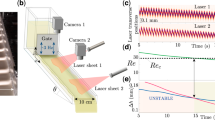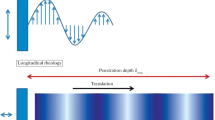Abstract
We have proposed a novel methodology using ultrasonic velocity profiling to estimate the effective viscosity of bubble suspensions that are accompanied by non-equilibrium bubble deformations in periodic shear flows. The methodology was termed “ultrasonic spinning rheometry” and validated on measurement of the effective viscosity of particle suspensions that has a semi-empirical formula giving good estimation of the actual viscosity. The results indicated that the proposed technique is valid for particle volume fractions below 3.0 %. Applying this to bubble suspensions suggested that the effective value of temporal variations in the capillary number, \(\hbox{Ca}_{\rm rms}\), is an important indicator to distinguish regimes in estimating the effective viscosity: Unsteady flows having larger \(\hbox{Ca}_{\rm rms}\) number than the critical capillary number for the deformation of bubbles are categorized into Regime 2 that includes both highly unsteady conditions and large steady deformation of bubbles.












Similar content being viewed by others
References
Ceccio SL (2010) Friction drag reduction of external flows with bubbles and gas injection. Ann Rev Fluid Mech 42:183–203
Choi SJ, Schowalter WR (1975) Rheological properties of nondilute suspensions of deformable particles. Phys Fluids 18:420–427
Derakhshandeh B, Vlassopoulos D (2012) Thixotropy, yielding and ultrasonic Doppler velocimetry in pulp fiber suspensions. Rheol Acta 51:201–214
Einstein A (1906) Eine neue Bestimung der Molekuldimensionen. Ann Phys 19:289–306
Feng ZC, Leal LG (1997) Nonlinear bubble dynamics. Ann Rev Fluid Mech 29:201–243
Frankel NA, Acrivos A (1970) The constitutive equation for a dilute emulsion. J Fluid Mech 44:65–78
Gonzalez FR et al (2010) Rheo-PIV analysis of the slip flow of a metallocene linear low-density polyethylene melt. Rheol Acta 49:145–154
Gonzalez JP et al (2012) Rheo-PIV of a yield-stress fluid in a capillary with slip at the wall. Rheol Acta 51:937–946
Hinch EJ, Acrivos A (1980) Long slender drops in a simple shear flow. J Fluid Mech 98:305–328
Kuwagi K, Ozoe H (1999) Three-dimensional oscillation of bubbly flow in a vertical cylinder. Intl J Multiphase Flow 25:175–182
Lamb H (1932) Hydrodynamics, 6th edn. Cambridge University Press, Cambridge
Llewellin EW, Manga M (2005) Bubble suspension rheology and implications for conduit flow. J Volcanol Geotherm Res 143:205–217
Llewellin EW, Mader HM, Wilson SDR (2002) The constitutive equation and flow dynamics of bubbly magmas. Gephys Res Lett 29:2170
Lu J, Tryggvason G (2007) Effect of bubble size in turbulent bubbly downflow in a vertical channel. Chem Eng Sci 62:3008–3018
Mooney M (1951) The viscosity of a concentrated suspension of spherical particles. J Colloid Sci 6:162–170
Murai Y, Oiwa H (2008) Increase of effective viscosity in bubbly liquids from transient bubble deformation. Fluid Dyn Res 40:565–575
Rust AC, Manga M (2002a) Bubble shapes and orientations in Low Re simple shear flow. J Colloid Interface Sci 249:476–480
Rust AC, Manga M (2002b) Effects of bubble deformation on the viscosity dilute suspensions. J Non Newton Fluid Mech 104:53–63
Shiratori T et al (2013) Development of ultrasonic visualizer for capturing the characteristics of viscoelastic fluids. J Vis 16:275–286
Takeda Y (ed) (2012) Ultrasonic Doppler velocity profiler for fluid flow. Springer, Germany
Takeda Y (1995) Instantaneous velocity profile measurement by ultrasonic Doppler method. JSME Int J Ser B 38:8–16
Taylor GI (1932) The viscosity of a fluid containing small drops of another fluid. Proc R Soc Lond Ser A 138:41–48
Tokuhiro A et al (1998) Turbulent flow past a bubble and an ellipsoid using shadow-image and PIV technique. Int J Multiph Flow 24:1383–1406
Vand V (1948) Viscosity of solutions and suspensions: I theory. J Phys Chem 52:277–299
Wang SQ et al (2011) Homogeneous shear, wall slip, and shear banding of entangled polymeric liquids in simple-shear rheometry: a roadmap of nonlinear rheology. Macromolecules 44:183–190
Wiklund J, Standing M (2008) Application of in-line ultrasound Doppler-based UVP–PD rheometry method to concentrated model and industrial suspensions. Flow Meas Instrum 19:171–179
Acknowledgments
This work was supported by JSPS KAKENHI Grant No. 24246033. The authors express thanks for this support.
Author information
Authors and Affiliations
Corresponding author
Appendix
Appendix
Variable separation as \(u_{\theta }(r, t) = F(t)G(r)\) modified Eq. (10) into two ordinal differential equations,
with connecting parameter \(\gamma \). By variable transformation of \(\zeta = \beta r\), Eq. (16) can be assumed as Bessel differential equation with \(n = 1\),
The general solution of this equation is given as a linear combination of Bessel function of first kind \(J_n\) and second kind \(Y_n\). To satisfy the boundary conditions, \(u_{\theta }(r=R, t) = U\sin \omega t = {\rm Im}[U\exp (i\omega t)]\) and \(u_{\theta }(r=0, t) = 0\), the solution should be
where \(C\) is arbitrary constant. Assuming \(F(t) = B\exp (i\omega t)\) as the solution of Eq. (15) with arbitrary constant \(B\) gives \(\gamma = -i\omega \). Then, \(\beta \) is determined as
We adopt \(\beta = (-1+i)k\) to represent the real phenomenon. Finally, \(u_{\theta }(r, t)\) is given as the imaginary part of the combined solution between \(F(t)\) and \(G(r)\) as
Here, the \(\varPhi (r)\), \(\varPsi (r)\), \(\varPhi _R\), \(\varPsi _R\) are, respectively, real and imaginary part of \(J_1(r)\) and \(J_1(r=R)\), and given in series as
where
Phase delay of the oscillation propagating in the fluid layer, \(\varTheta (r)\), in the form of
is given as
Rights and permissions
About this article
Cite this article
Tasaka, Y., Kimura, T. & Murai, Y. Estimating the effective viscosity of bubble suspensions in oscillatory shear flows by means of ultrasonic spinning rheometry. Exp Fluids 56, 1867 (2015). https://doi.org/10.1007/s00348-014-1867-5
Received:
Revised:
Accepted:
Published:
DOI: https://doi.org/10.1007/s00348-014-1867-5




